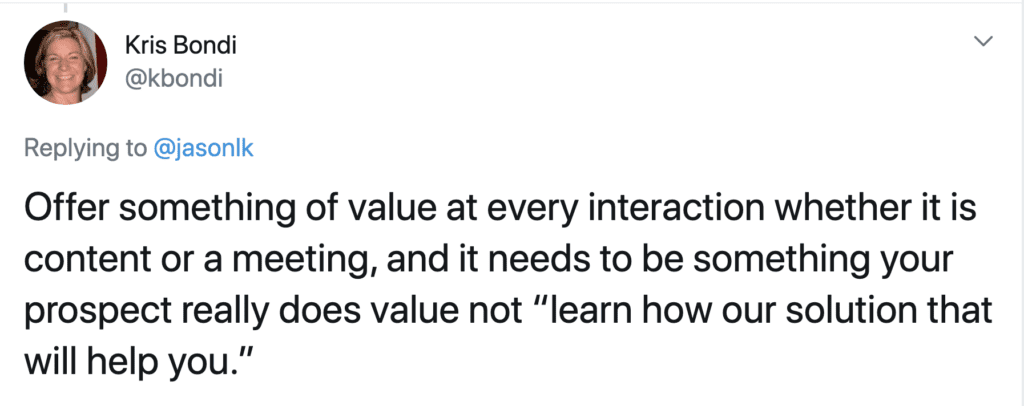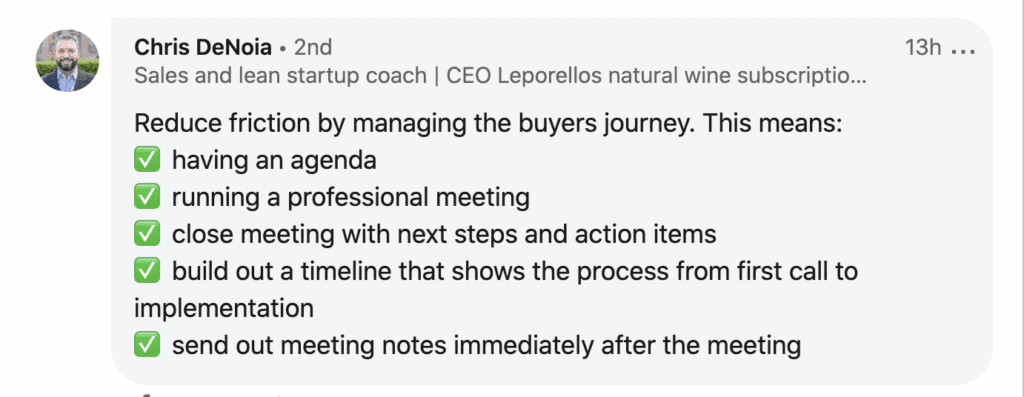I recently put out a call on Twitter and LinkedIn on folks’ top tip to take friction out of their sales processes. I put together an excerpt video here of a few of my thoughts …
but even better, we got great #1 top ideas from everyone from the GM of Shopify Plus to the CRO at Brex. I think it would be a tremendous exercise to share these ideas with your team and see what folks think they should change / implement at your startup. I bet things will get even better if you do:
“Say no to a non-ideal prospect as fast as you can” — Loren Padelford, GM of Shopify Plus
“Presumptive close in a transactional sale. “At the end of the call we’ll walk through the application so you can start trying the product” — Sam Blond, CRO, Brex
“Short video overview of the product and a free trial without a credit card” — Muthu Kumar, CEO Eventzilla
“We added slack for customer support and on boarding” — Adam Livesay, founder, Elevat
“Simplicity. In everything. In your messaging. In your website. In your service offerings. In your proposals. In your pricing. In your contracts. All of it.” — Michael Hernum, CEO at ESG
“Help people buy how they want to buy and be as transparent as you can with pricing” – Ken Edwards, Sales leader, Uberflip
“Listen. Take good notes. Recap the meeting to ensure alignment.” — Preston Clark, cofounder, LawInsider
“Create a mutual milestone doc for prospects to outline a path to implementation. Lack of clarity and alignment can create friction for both the prospect and the rep.” — Jesse Woodbury, Enterprise Sales, GoQuiq
“Flat pricing for paid pilots” — CEO & Co-founder, ToneDen
“Pacakage in extras, all users, projects, features into the price and reduce any hidden costs in contracts. In my experience prospects will pay a higher price upfront if all is included – save upsells for unreleased product” — Michael Menke, Built Technology
“Weekly “W” email that keeps the economic buyer and the stakeholders in the loop. Focus on what got accomplished, what’s next and issues that need resolution.” — Dave Kranowitz, CRO Worldwide Sales, Grafana Labs
“Sell to the next step not jumping to the close” — Jason Hamilton, Co-Ceo, TestLauncher
“E contract” — Julie Grieve, CEO CritonHQ
“Route highly scored leads directly to AE’s” — Shamus Noonan, Sales Leader, Crunchbase
“Sell to the right people” — Jen Abel, Co-founder, Jjellyfish
“Enterprise: build an agreed upon project plan with your buyer and review it together every week until signature. SMB: build a pitch that enables a one-call close: include an ROI sample, relevant case study, and proactive answers to common objections. And take credit cards.” — Brian Manning, SVP, PatientPing
“Majority of deals are lost to no decision. Therefore, challenging the status quo is the first priority for reducing friction.” — Lish Gates, Senior Manager, Algolia
“Don’t send a Calendly asking your prospect to pick a time” — Ryan Pereus, CEO, Superhuman Prospecting
“In SaaS, there’s an easy TOP to this list: Transparent pricing and the ability to sign up paying monthly with no commitment. The amount of time companies waste negotiating and forcing people to buy unneeded licenses to “get the best price” is without question the least favored part of the buying process for the customer. Sure, there are reasons for doing it, but if the question is how to remove friction and increase sales velocity, this one change is FTW. Of course, if your product sucks this won’t work. But if your product sucks you’ve got bigger problems.” — Collin Cadmus, previously VPS, Aircall
“Set up expectations through out the sales process with your clients and be up front of what they should expect from you.” — Smeet Parikh, Corporate Sales Rep, Palo Alto Networks
“Make sure your team is enabled and empowered. Have clear rules supported by strong operations so that they can focus on product knowledge and how it solves their prospects’ problems.” — Claire Gunter, Sr Partner Account Manager, Algolia
“Every time you want to ask your prospect to do something as part of the sales process, make sure their “homework” is as easy as possible.” — Alex Boyd, CEO, RevenueZen
“A proper discovery mixed with 100% transparency. I’ve had so many hungry salespeople sign anyone up in order to get commission but those customers later churned. Not only did they churn, but they caused a lot of issues and wasted time for our CS team, and tech support. Doing a proper discovery call will avoid all that. You’ll end up signing people up that fit the mold. Add transparency to the mix, and you won’t have to find yourself in a he said she said debate. Get everything in writing to put the finishing touches. To add to that, here’s the cherry on top… if I can somehow find a reference that knows the lead really well that can make that formal introduction, that reduces the friction big time.” — Mor Assouline, Senior Account Director, Okendo
“Do your homework up front. Good discovery conversations will help you identify the prospect’s problems and buying process. Getting them to talk about those problems creates some sense of ownership and commitment to the sales process and allows you to match your sales plan to the buyer’s buying process.” — BrianBall, SVP Sales, Doumoso
“Customer centricity is 🗝️for long term success. Ask powerful questions and understand the value. If there is no value, it’s not a fit. Don’t go ahead! hashtagfocus If it’s a fit: deliver fast, be trustworthy and talk the same language (it makes a huge difference if you talk to users of your product – your influencers, or the decision maker)! One question you should ask yourself in different stages of every sales process: Do I believe that they’re gonna be successful or not?” — Daniel Kurrasch, VP Sales, Style
“This is less a specific tactic than an exercise: Win/loss analysis – ask 3 recent wins, 3 recent losses and 3 recent no decisions the biggest hangups in their buying cycle (ideally specify early funnel, mid funnel, end of funnel). It takes some time to organize and 80% of the good ideas you learn you will know/have thought of at some point anyway. The 20% of good ideas you hadn’t considered are worth minimum 5-10 deals with the upside in the 100s of deals. There are very few exercises with this level of ROI.” — John Thackston, VP Business Development * Founder, SOAR Performance Group
“Lead Scoring. It all boils down to ICP / Fit. Every other conversation and interaction is a ripple effect from whether they understand the value of what you provide.” — Alex Kaye, VP Revenue,
“First and foremost know (ask) why they took the meeting and what they care about. This should be part of the process. Then proceed. Next up would be pricing and pricing plans structure. Simple as can be and packed with overwhelming value. Followed up by moving legalese to your site and linking to them vs making them take up your order form. People toss around legal and terms when it’s not even asked for.” — Patrick Baynes, CEO, Nerdwise
“Ask your prospect which of their current suppliers is the most skilled at understanding how to do business with them personally and their organization. There are a series of preliminary and additional next steps from that point… but, this is the key question that takes the most friction out of the process.” — Mark Bucan Jones, Sales Director
“Cut down the number of hoops they have to jump through to actually make the purchase. I have quit making a purchase that I was set on buying simply because I couldn’t give them my money easily enough.” — Tyler Burch, Director Digital Marketing, BoardActive
“Less touch-points and qualification before you loop in the right contact (Account Exec). Buyers expect value immediately and a POV on why you, why now.” — Jeff Poczatek, Director Mid-Market Sales, Showpad
“Understand the “personal/professional” win or motivation for every stakeholder… and align messaging accordingly. Bonus idea: Understand “how” they buy not just “why” — Ray Rike, Founder and CEO, RevOps Squared
“Make next steps a win-win for them, as much as possible at least as much as possible” — Ryan Rudin, CEO, Bizzit
“When they ask a question, be prepared to answer it sans 50 steps in your process. Making a buyer go through multiple steps and handoffs where they have to have the same conversations is horrible.” — Amy Volas, CEO, Avenue Talent Partners
“Have your ICP tight so you can have low qualification threshold for SDRs (no BANT, etc) allows you to get demos into AE’s hands faster.” — Ashley Kelly Mealy, Sr Director, Sales Development, Brex
“I would say it starts the second a prospect wants to act on a CTA within your website or LP. Let’s make it as easy as we can for our prospects to start a conversation with us, immediately. The B2C experience in. B2B environment. 1. Can they book a time directly with your sales team from the form? If they qualify further based on firmographics, can they skip a step in your qualification process and get to product faster? 2. Can they chat with you “live” in these scenarios (website, trial) almost immediately? Removing needs for check-ins. Live buyer enablement is true value. If we can decrease time to conversations, and increase time to value on your product. You’ll be a large step ahead.” — Rob Anderson, Sales Development, Docebo
“One question you should ask yourself in different stages of every sales process: Do I believe that they’re gonna be successful or not?“ — Daniel Kurrasch, VP Sales, Styla
“90-day opt-outs if the ACV is > $150k for early-stage enterprise SaaS.” — MatthewTillman, Founder, Haven
“Depends on where you are in the funnel, but for post-SDR tip, I’d say making sure you show a demo on the first call. I can’t remember the last product I bought where someone tried to make me take a scheduled “disco” call and then schedule a follow up call to show me a demo (quick 5 min SDR call to qualify an IB lead does not count). Closely related would be to hire reps who can run their own first demo. Sure, many products require an SE to close a deal, but IMO, great reps should be able to click around in a product and speak at a high altitude for a 1st demo. Lots of friction if you need an SE on every 1st demo” — Matt Plank, VP Sales, Rippling
You can review more of the top tips here and here.









